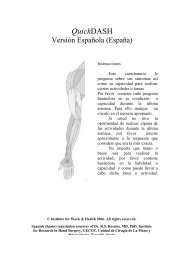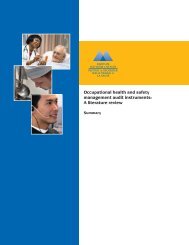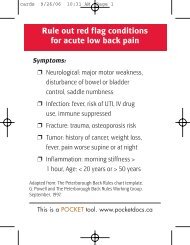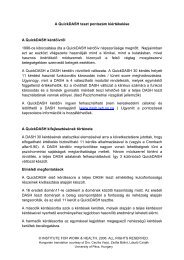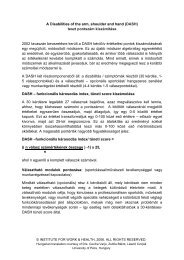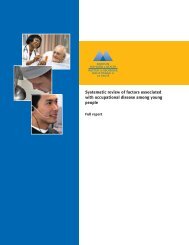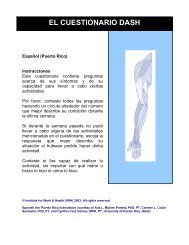A systematic review of injury/illness prevention and loss control ...
A systematic review of injury/illness prevention and loss control ...
A systematic review of injury/illness prevention and loss control ...
- No tags were found...
You also want an ePaper? Increase the reach of your titles
YUMPU automatically turns print PDFs into web optimized ePapers that Google loves.
Caution: Do not describe the intervention in great detail. It will be described in Q12.*Use notation (I 1 –Intervention #1, I 2 –Intervention #2, C 1 Control Group #1, C 2Control Group #2, I 1 C –crossover with intervention first, I 2 C –crossover withintervention second).R<strong>and</strong>omized Field TrialNon-r<strong>and</strong>omized Field Trial with concurrent comparison groupR<strong>and</strong>omized Cross-Over DesignNon-r<strong>and</strong>omized Cross-Over DesignPre-post Design with NO <strong>control</strong>OtherR<strong>and</strong>omized Field Trial -a field study where the intervention assignment is r<strong>and</strong>omized.R O X OO ONon-r<strong>and</strong>omized Field Trial with concurrent comparison group – a field study where theintervention assignment is not r<strong>and</strong>omized <strong>and</strong> the information on the <strong>control</strong>s is collectedconcurrently with the information for the treatment.O X OO OR<strong>and</strong>omized Cross-Over Design: –a field study where two groups receive the intervention atdifferent times <strong>and</strong> group assignment is r<strong>and</strong>omized.R O X O OO O X ONon-r<strong>and</strong>omized Cross-Over Design –a field study where two groups receive theintervention at different times <strong>and</strong> group assignment is not r<strong>and</strong>omized.O X O OO O X O11. What type <strong>of</strong> <strong>prevention</strong> did the study investigate (choose only one)? Indicatewhether the study evaluated a primary or secondary <strong>prevention</strong>/intervention. The classicaldefinition <strong>of</strong> primary <strong>prevention</strong> is defined as an intervention aimed at preventing healthypeople from progressing on to symptom or disorder. The classical definition for tertiary<strong>prevention</strong> is defined as intervention aiming to prevent people with clinically recognizeddisorders from further morbidity <strong>and</strong> mortality. Although these definitions are accepted inpublic health literature, to be comparable to other IW&H <strong>review</strong>s, we will use the termsprimary <strong>and</strong> secondary (instead <strong>of</strong> tertiary) for those definitions.To determine what the authors “aimed” to do, <strong>review</strong>ers must only answer based on whatwas reported by the authors. Therefore, any studies where clinical diagnoses or symptoms (aspart <strong>of</strong> a case definition) were used to identify <strong>and</strong> include participants with disorders will beclassified as secondary <strong>prevention</strong>. If a study excluded employees with clinical diagnoses orsymptoms to create a cohort <strong>of</strong> individuals free from symptoms this would be considered aprimary <strong>prevention</strong>. If no such exclusions were made, then the authors will be assumed to76 Institute for Work & Health



